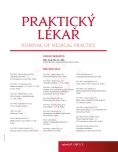Changes in dietary habits among adolescents in relation to body weight (HBSC 2002–2014)
Authors:
J. Voráčová; E. Sigmund; D. Sigmundová
Authors‘ workplace:
Vedoucí: prof. PhDr. Karel Frömel, DrSc.
; Fakulta tělesné kultury
; Institut aktivního životního stylu
; Univerzita Palackého v Olomouci
Published in:
Prakt. Lék. 2017; 97(2): 82-86
Category:
Of different specialties
Overview
Objective:
The main aim of the present study was to evaluate trends in six eating behaviours of Czech adolescents in relation to their body weight between 2002–2014. The partial aim was to monitor the differences in eating behaviours between adolescents with normal body weight and obesity in 2002, 2006, 2010 and 2014.
Methods:
The data was obtained from the Czech HBSC (Health Behaviour in School-aged Children) survey in 2002, 2006, 2010 and 2014. Body weight category was determined by body mass index (BMI) and eating behaviours were obtained from a questionnaire filled by 11-, 13- and 15-year-old adolescents. Logistic regression (Enter method) (odds ratio – OR and 95% confidence interval – CI) was used to analyse changes in eating behaviours and the differences between body weight categories were calculated by chi-square test.
Results:
From 2002 to 2014, the data showed a significant decrease in consumption of soft drinks (normal body weight OR: 0.47; CI = 0.42–0.52; overweight OR: 0.47; CI = 0.36–0.63, and obesity OR: 0.47; CI = 0.29–0.75). In addition, the changes in trends were seen in daily consumption of sweets (OR: 0.81; CI = 0.74–0.90), fruit (OR: 0.81; CI = 0.74–0.88) and breakfast on weekdays (OR: 1.28; CI = 1.17–1.39), however, significant change was only in adolescents with normal body weight. There was no change in consumption of vegetable or breakfast on weekends. Lower prevalence was reported in consumption of sweets (all survey years), soft drinks (only in 2006) and breakfast on weekdays/weekends (only in 2006) in obese adolescents.
Conclusions:
Monitoring dietary trends in Czech adolescents in relation to body weight category is important for evaluation of current projects and development of new programmes targeted to decrease differences between body weight categories in adolescents.
KEYWORDS:
eating behaviours – adolescents – HBSC – trends – body weight
Sources
1. Ng M, Fleming T, Robinson M, et al. Global, regional, and national prevalence of overweight and obesity in children and adults during 1980–2013: A systematic analysis for the Global Burden of Disease Study 2014. Lancet 2014; 384(9945): 766–781.
2. Simmonds M, Llewellyn A, Owen CG, Woolacott N. Predicting adult obesity from childhood obesity: a systematic review and meta-analysis. Obes Rev 2016; 17: 95–107.
3. Olsen NJ, Heitmann BL. Intake of calorically sweetened beverages and obesity. Obes Rev 2009; 10: 68–75.
4. Szajewska H, Ruszczynski M. Systematic review demonstrating that breakfast consumption influences body weight outcomes in children and adolescents in Europe. Crit Rev Food Sci Nutr 2010; 50: 113–119.
5. Mytton OT, Nnoaham K, Eyles H, et al. Systematic review and meta-analysis of the effect of increased vegetable and fruit consumption on body weight and energy intake. BMC Public Health 2014; 14: 886.
6. Emmett PM, Jones LR. Diet, growth, and obesity development throughout childhood in the Avon Longitudinal Study of Parents and Children. Nutr Rev 2015; 73(Suppl 3): 175–206.
7. Lazzeri G, Ahluwalia N, Niclasen B, et al. Trends from 2002 to 2010 in daily breakfast consumption and its socio-demographic correlates in adolescents across 31 countries participating in the HBSC Study. PLoS One 2016; 11: e0151052.
8. Pala V, Lissner L, Hebestreit A, et al. Dietary patterns and longitudinal change in body mass in European children: a follow-up study on the IDEFICS multicenter cohort. Eur J Clin Nutr 2013; 67: 1042–1049.
9. Vereecken C, Pedersen TP, Ojala K, et al. Fruit and vegetable consumption trends among adolescents from 2002 to 2010 in 33 countries. Eur J Public Health 2015; 25(Suppl 2): 16–19.
10. Voracova J, Sigmund E, Sigmundova D, Kalman M. Changes in Eating Behaviours among Czech Children and Adolescents from 2002 to 2014 (HBSC Study). Int J Environ Res Public Health 2015; 12: 15888–15899.
11. Ogden CL, Carroll MD, Kit BK, Flegal KM. Prevalence of obesity and trends in body mass index among US children and adolescents, 1999–2010. JAMA 2012; 307: 483–490.
12. Sigmund E, Sigmundova D, Badura P, et al. Temporal trends in overweight and obesity, physical activity and screen time among Czech adolescents from 2002 to 2014: A National Health Behaviour in School-Aged Children Study. Int J Environ Res Public Health 2015; 12: 11848–11868.
13. Driessen CE, Cameron AJ, Thornton LE, et al. Effect of changes to the school food environment on eating behaviours and/or body weight in children: a systematic review. Obes Rev 2014; 15: 968–982.
14. Hebert JR, Hurley TG, Peterson KE, et al. Social desirability trait influences on self-reported dietary measures among diverse participants in a multicenter multiple risk factor trial. J Nutr 2008; 138: 226S–234S.
15. Bel-Serrat S, Julian-Almarcegui C, Gonzalez-Gross M, et al. Correlates of dietary energy misreporting among European adolescents: the Healthy Lifestyle in Europe by Nutrition in Adolescence (HELENA) study. Br J Nutr 2016; 115: 1439–1452.
Labels
General practitioner for children and adolescents General practitioner for adultsArticle was published in
General Practitioner

2017 Issue 2
Most read in this issue
- Firearm license – a summary of changes in the assessment of medical fitness of applicants
- Reasons for hospitalization in patients diagnosed from the schizophrenia, schizotypal and delusional disorders
- The practical application of clinical criteria for the recognition of the disease of the lumbar spine from overloading as an occupational disease
- Optical coherence tomography application in diagnostics and monitoring of idiopathic intracranial hypertension patients
